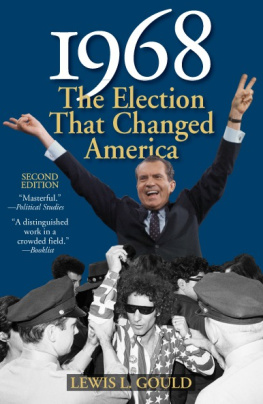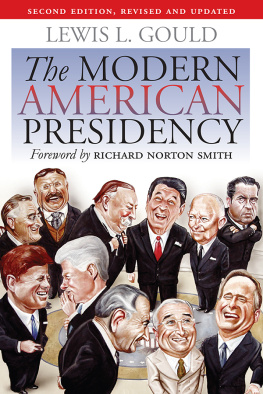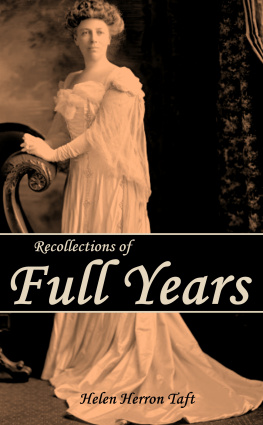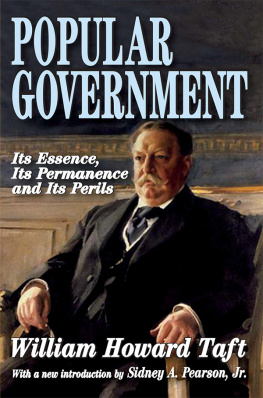CHIEF EXECUTIVE TO
CHIEF JUSTICE
Taft betwixt the White House and
Supreme Court
LEWIS L. GOULD
UNIVERSITY PRESS OF KANSAS
2014 by the University Press of Kansas
All rights reserved
Published by the University Press of Kansas (Lawrence, Kansas 66045), which was organized by the Kansas Board of Regents and is operated and funded by Emporia State University, Fort Hays State University, Kansas State University, Pittsburg State University, the University of Kansas, and Wichita State University
Library of Congress Cataloging-in-Publication Data
Gould, Lewis L.
Chief executive to chief justice : Taft betwixt the White House and Supreme Court / Lewis L. Gould.
pages cm
Includes bibliographical references and index.
ISBN 978-0-7006-2001-2 (cloth : alk. paper)
eISBN 978-0-7006-2041-8
1. Taft, William H. (William Howard), 18571930. 2. PresidentsUnited StatesBiography. 3. United StatesPolitics and government19131921.
I. Title.
E762.G68 2014
973.91'2092dc23
[B]
2014020688
British Library Cataloguing-in-Publication Data is available.
Printed in the United States of America
10987654321
The paper used in this publication is recycled and contains 30 percent postconsumer waste. It is acid free and meets the minimum requirements of the American National Standard for Permanence of Paper for Printed Library Materials Z39.481992.
ACKNOWLEDGMENTS
Many people helped me write this book about William Howard Taft. The staff of the Perry-Castaneda Library at the University of Texas at Austin facilitated my use of the William Howard Taft Papers on microfilm over the course of many years. Clarence and Geri Lasby provided warm hospitality when I returned to Austin for follow-up research in 2013. They have been vital friends for almost half a century. I also want to acknowledge the kindness and support that H. Wayne Morgan extended to me when I first came as a young scholar to the University of Texas in the late 1960s. He was a fine scholar of the Gilded Age and a wonderful teacher.
Kristie Miller of Washington, D.C., helped me renew connections with the Library of Congress that had lapsed for two decades, during an important visit there in November 2013. Her enthusiasm for manuscript research stimulated my own memories of that process and enabled me to accomplish a great deal in a short time.
At Monmouth College, Richard Sayre, director of the Hewes Library, and his talented staff made it possible for me to use the services of the interlibrary loan program to secure needed reels of the Taft Papers in the concluding phase of the project. In my daily life, Mary Lou Pease provided vital assistance with getting me places and keeping me together
Laura Kalman gave the manuscript a thorough reading that tightened the prose and addressed many important substantive issues. Simon and Stacy Cordery sustained me during the transition from Austin to Monmouth in more fruitful ways than I can enumerate. Stacy also read the manuscript and added her timely suggestions for improvement and clarity.
This book was the first I have written over the past four decades without the encouragement and wise counsel of Karen Gould. It reminded me how much I depended on her affection and support. Dedicating this work to her memory will, I hope, indicate how much I miss all of her presence in my life.
Lewis L. Gould
Monmouth, Illinois
January 2014
CHIEF EXECUTIVE TO
CHIEF JUSTICE
INTRODUCTION
William Howard Taft is the only American politician to have been both president of the United States and chief justice of the United States. That special distinction, while often noted, has not resulted in much sustained biographical attention to Tafts long public career. The standard two-volume biography of him, written by Henry F. Pringle and published in 1939, has withstood subsequent attempts to replace it. At 232 pages, however, Luries account does not delve in great depth into any specific phase of Tafts career during the period he covers.
Tafts presidency has attracted more attention. Two books in the 1970s examined his time in the White House. Donald F. Anderson used the presidents personal papers and the perspective of a political scientist to provide an in-depth study of one conservatives exercise of political power.
Constitutional and legal scholars have devoted a great deal of time and energy to understanding Tafts tenure on the Supreme Court after 1921. Allen E. Ragans Chief Justice Taft was an older survey of his leadership of the court.
As this review of the literature on Taft indicates, the eight years that he spent out of office and in private life have attracted little attention from his historians and biographers. Scholars note that he taught law and constitutional history at Yale University, opposed the nomination of Louis D. Brandeis to the Supreme Court in 1916, served on the National War Labor Board during World War I, was identified with the League to Enforce Peace and the fight for the League of Nations, and made up his differences with Theodore Roosevelt in 19171918. These cursory observations have exhausted historical interest in what might be called Tafts years in the political wilderness.
Finding Taft an intriguing and complex historical figure as president, I decided to explore what those eight years were like for the former chief executive. This book is the result of that endeavor. I discovered that from 1913 to 1921 Taft was involved in more causes and issues than previous writers had realized. There was an abundance of information about his work as president of the American Bar Association from 1913 to 1914. His service on the Commission to create the Lincoln Memorial revealed new information regarding that iconic part of monumental Washington. Taft was also immersed in the organization and service of the American Red Cross through his friend Mabel Boardman. In his relations with Woodrow Wilson and the Democratic administration, Taft became a persistent and sometimes strident critic of the governments policy toward the Philippine Islands.
These concerns meshed with the issues that have received more scrutiny about Taft. A major theme of this book is his interaction with Woodrow Wilson, in which Taft often supported the president in public while detesting him in private. Their ambivalent relationship had a significant impact on the battle over the League of Nations in 19191920. As a friend of the proposed league, Taft sought to promote American entry into an international organization while at the same time preserving his credentials within the Republican Party. The opposition of the Grand Old Party to anything identified with Wilson made Tafts task in this area complex and in the end frustrating.
Finally there was Theodore Roosevelt. For the first half of Tafts transitional eight years, he waged an intense effort within the Republican Party to marginalize his former friend and benefactor. Defeating Wilson was a goal they shared, but Taft did not want Roosevelt to regain a place of authority and power within the GOP just to oust Wilson from the White House. Once the United States entered World War I in April 1917, the common animus drew the one-time adversaries back into an awkward marriage of political convenience. By late 1918 it was Will and Theodore once again but that was largely a facade. Mistrust and doubt governed their collaboration.







